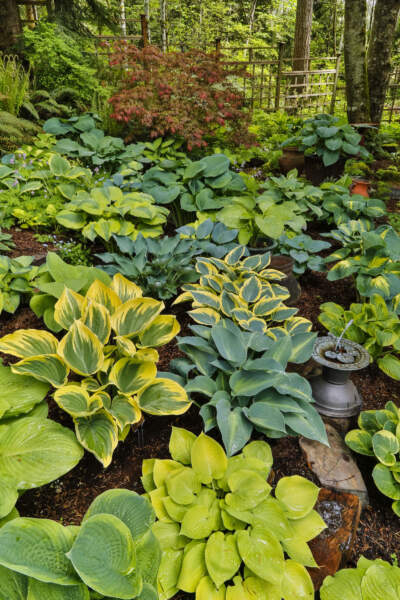Advertisement
Commentary
I'm a feckless gardener — and that's OK
Resume
My gardening friends are at it all year long — marking up nursery catalogs seven or eight months in advance of the first crocus, ordering seeds and buying potting mix to fill the egg cartons they’ve been saving for months, counting the days until planting can commence.
Not me. With the first frost, I banish all thoughts of plants and planting with a sigh of relief. As spring approaches, I wonder if I should just let nature take her course this year and surrender to the weeds. Que sera, sera.
But that doesn’t happen. I’m too Type A to give up.
I am my mother’s daughter — a balleboste — Yiddish for literally, “mistress of the house.” In action it’s more like “commander-in-chief.” My father used to say the only place cleaner than our house was a Swiss hospital.
I don’t think I’m quite as crazy as my mother, but the first thing I do every morning — even before coffee and walking the dog — is load the dishwasher with stray glassware, wipe down the counters and hang up stray jackets and sweaters.
As a gardener, however, I am aimless, careless, unreliable, impulsive, slap-dash and impatient: I am feckless — a word I never used before — either out loud or in print.
Serious gardeners can tell you the name and provenance of their plants. They know which ones need shade, which thrive in full sun and which will attract butterflies. Serious gardeners arrive at the local nursery the week it opens, with plans and a shopping list: maybe a fern for the bare spot over here, a new climber for the fence near the trash barrels.
And after ruining too many sneakers, I broke my own 11th commandment, “Thou shalt not wear Crocs"
I can’t tell you the name of the red flowers that came up by my back door, because I didn’t save the little plastic information signs when I bought them last year — or maybe it was two years ago. I probably chose them because they were pretty, perennial and on sale.
I don’t bother much with annuals; they bloom too briefly and wilt within weeks. Not worth the effort. I tried growing tomatoes a few times; not one tomato ensued. Over and out.
I took to perennials — flowers, succulents, ferns and grasses — as investments in regular, unearned returns.
I believed that perennials would, after a year or two, just bloom and bloom, and I could swan around in a hat and snip flowers to decorate the house for the next country dance. Which is what comes of watching too many movies based on Jane Austen novels. But like all living things, perennials die.

When I saw that my clematis had sent up shoots from among last summer’s brittle stems, it felt like a miracle. I was encouraged to commit to another season in the weeds.
Over the years I’ve accumulated a basic toolkit: trowels, a weeder, hand rake, gardening gloves and recently a kneeler — a blessing for the back as well as the knees.
And after ruining too many sneakers, I broke my own 11th commandment, “Thou shalt not wear Crocs,” classifying them as garden tools rather than footwear.
My efforts are mostly concentrated on a purely aspirational border of perennial flowers (half of what I plant returns a second year, if I’m lucky) which surrounds a modest rectangle of “lawn.” The “lawn” is mostly weeds: crabgrass, plantain, splurge, spear thistle and dandelions, which pose as flowers only to send fluffy weed bombs from May through September. I don’t use poison, so I spray them with vinegar, pour boiling water on them, and dig up countless tap roots; nothing works. I hate them with energy-wasting passion.
The only part of my domain that remains free of dandelions is a shaded slope of black-brown mulch, which came with the house when we bought it. Over the years, I attempted to add some color to all that brown with hardy ground covers — a grass mixture guaranteed to grow in shade — and clover.
I fought the mulch, but the mulch won.
The previous owners didn’t spend much time in the yard. But they left a healthy cluster of irises, two patches of daffodils and several hosta plants — all of which blossom without any interference from me. Some of their leaves measure two feet from stem to tip. Passers-by stop to marvel.
One year, the hostas got so big and spread so wide, I dug up roots and leaves from around the edges and planted bits in bare spots. But it wasn’t long before the transplants started to take over, so I moved them to the valley of the shadow — where they prospered.
Last summer, my brother came for a visit. Harry is a six-feet-tall do-it-yourselfer who has never seen a home or garden improvement project he didn’t jump on. He insisted we move even more hostas into the shade, including one the size and weight of a Saint Bernard.
I fought the mulch, but the mulch won.
It took hours, but he dug it up and dragged it on a plastic tarp to its new home. We spent hours digging a hole for it through the thickly matted, multi-layered root system of the overhanging tree. Not fun.
But when we finished, the black hole had been transformed into what looked like a planned hosta garden — which I subsequently learned is a cliché among some gardening cognoscenti.
That was last August. I wondered all winter what would happen to the hostas. Did we preserve enough of the root systems? Would it have been worth the broken fingernails, the sore muscles, the time we might have spent relaxing by the sea?
The answer is yes! The hostas are thriving!
Of course, the weeds are back in full force, but I am determined to do nothing no more than mow them down as if they were grass.
More than half of my perennial flowers died over the winter, but with my new outlook on life, I’m taking that as a win.
I still claim the title of balleboste in the house. But outside, I’m letting my feckless fly.
